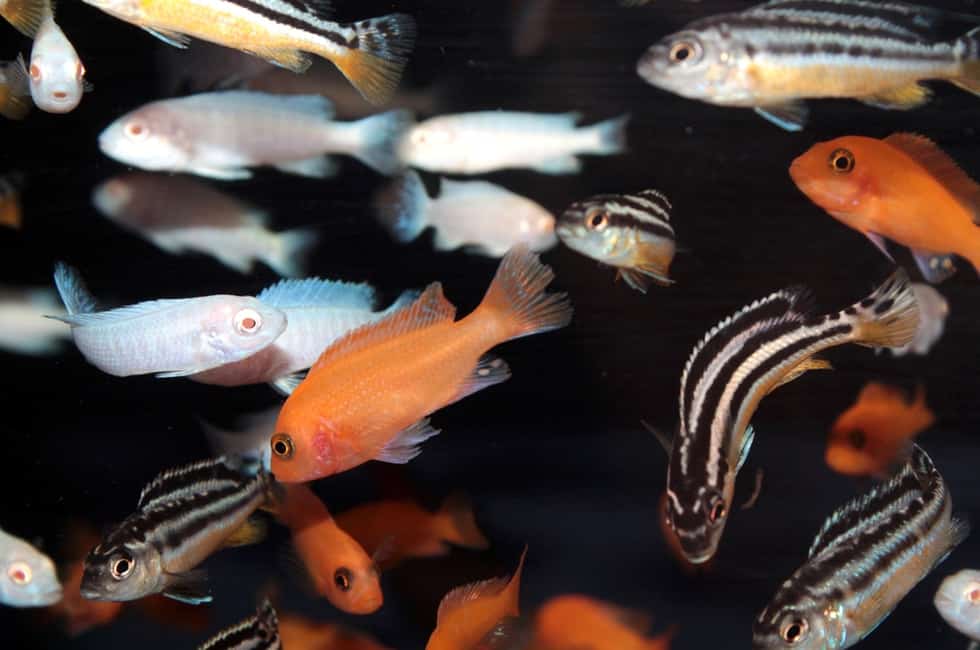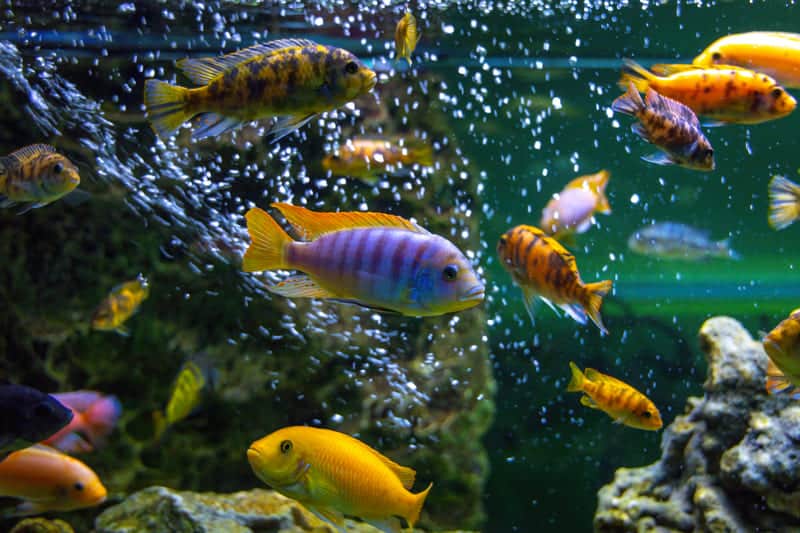There are various vibrant fish you will spot in an aquarium. Amongst them, African Cichlids are exotic tropical fish that are easy to take care of! When it comes to African Cichlids, there are tons of species available and they come in varying shapes, sizes, and colors.
Generally, African Cichlids kept in home aquariums can grow up to anywhere between 2 inches to 8 inches. Depending on the type of species you get, the size of the aquarium will also vary.
Dive to learn more about how big African Cichlids get, maintenance tips, the best species to get, and more!
How Big Do Most African Cichlids Get?
Did you know that the famous Lake Malawi is home to almost 700 species of African Cichlids? Generally, African Cichlids grow up to 4 inches.
Sometimes, however, they can also grow up to 6 inches. In the case of African Cichlids, a tank that is almost 30 to 45 gallons will suffice.
Peacock Cichlids are one of the most popular species out there and can grow up to anywhere between 4 to 6 inches. You will need a tank that is at least bigger than 45 gallons.
Meanwhile, the well-known Electric Yellow Tabs are known for being extremely peaceful and easy to take care of.
The Electric Yellow Tabs grow up to about 3 to 3.5 inches and you will have no trouble fitting at least 5 of these Cichlids in a 30-gallon aquarium. If you don’t have the requisite space to fit a big fish tank, I would recommend that you go for this type of Cichlids.
How Fast Do African Cichlids Grow?
African Cichlids are known for being extremely vibrant in nature. They can add a lovely touch to your aquarium and make it an instant crowd-puller.
It is extremely important to maintain these Cichlids and provide them with the required nutrients on a regular basis. In addition to nutrition, the growth of African Cichlids is heavily dependent on the quality of their environment.
More: How Long Do African Cichlids Live?
Certain Cichlids grow at an extremely rapid pace as compared to the rest. For instance, the Bolivian Ram Cichlids are well known for growing up to almost 3 inches within the first few months of their lifetime.
Similarly, the famous Jack Dempsey Cichlids can also grow up to a whopping 5 inches in the first four months! It is, therefore, recommended that you pick the right aquarium for your fish after careful consideration.
It is extremely important to replicate the natural living conditions of the Cichlids in the aquarium as closely as possible to encourage their growth. Adding rocks to your fish tank is a must to make the fish feel comfortable in their environment.
The Mbuna Cichlids tend to grow best in environments that boast a decent amount of rocks. On the other hand, Rainbow cribs love a good cave inside their aquariums.
It is crucial to ensure that the water in the fish tank contains low nitrates and boasts the right Ph level on a weekly basis. Moreover, regular filtration is the key to decreasing toxins in the water. Finally, you should feed your fish top-quality food in small proportions to warrant good health and timely growth.
What Size Tank Do I Need for African Cichlids?
As mentioned earlier, the size of your tank will depend on the type of African Cichlids you choose to get. There are as many as 1600 species of Cichlids available across the globe and Lake Malawi, the African Great Lake, is home to almost 700 African Cichlids Species.
Cichlids that are larger in size tend to showcase a rapid growth spurt in the first few months of their lifetime. However, their growth slows down as they continue to mature.
- Discus Fish, a variety of African Cichlid, tend to grow up to 4 inches and reach maturity in almost 6 months. This means that every Discus Fish will require at least 10 gallons worth of space inside the tank.
- The Electric Blue Hap tends to grow up to 6 inches and you will need at least 55-60 gallons worth of tank space to accommodate at least 4 to 5 of these Cichlids.
- Angel Fish, on the other hand, also grows up to 6 inches but they grow very slowly. For these types of fish, you are better off with a tank that provides 20 gallons worth of space for each fish.
- Oscars Cichlids may not be the largest Cichlids but they tend to grow up at a rapid pace. Moreover, this fish is also known to be aggressive which is why you should make sure to provide at least 50 gallons worth of fish tank space for this type of Cichlid.
- African Cichlids, known as “Dwarf Cichlids”, can grow up to as much as 4 to 5 inches. Typically, a pair of dwarf cichlid can be kept in a 10 or 20-gallon tank. However, it is best to opt for bigger tanks for a group of cichlids.
How Big Do Small African Cichlids Get?
There are certain Cichlids that are commonly referred to as Dwarf Cichlids and they grow up to about 4 to 5 inches. If you wish to get a smaller tank, you are better off with the small and vibrant dwarf Cichlids.
If you wish to see them grow a bit bigger than usual, you should focus on providing them with the optimum living environment, top-quality food, and so forth.
Another species of small Cichlid is the common Convict Cichlid. This fish grows up to 6 inches but it takes a long time to reach maturity.
It takes them almost 5 years to mature into full-grown fish. However, it is important to note that this fish is a bit aggressive in nature which is why it is best to keep them in tanks sized 40 gallons.
When it comes to Mbuna Cichlid, you can fit 4 of them easily in a 30-gallon tank. Meanwhile, the Bolivian Ram Cichlid is another one of the common Small African Cichlids that tends to achieve full maturity in a period of three months. So, a small tank will accommodate this fish without any hassle.
Please keep in mind that most African Cichlids tend to reach full maturity in 2 years and it can take them anywhere between three months to a year to rich their full potential when it comes to coloration.
If you wish to encourage fast coloration in your African Cichlids, you can get them started on a diet of color-enhancing foods.
How Big Do Yellow African Cichlids Get?
The Electric Yellow Cichlid is one of the most popular types of African Cichlids across the globe and can effectively light up your aquariums unlike any other.
This African Cichlid species gets its name due to its vivid yellow coloration. When they are fully matured, you will be able to spot visually striking black stripes.
The Yellow African Cichlid is a favorite of fish enthusiasts or aquarium owners due to its striking colors, calm and peaceful behavior, and so on.
Just like other varieties of fish, it is significant to replicate the natural habitat of the Yellow African Cichlid to ensure their growth. We would recommend that you fill the aquarium with caves, rocks, and vibrant plants.
This type of African Cichlid grows up to a size of 5+ inches. You can easily grow 1 to 4 Cichlids in a 10 gallons worth of fish tank.
This means that a 45 gallons worth of tank is enough to accommodate 10 to 15 Yellow African Cichlids.
If you wish your baby Yellow Cichlids to mature into their beautiful grown-up selves, it is important to feed them quality food in the form of bloodworms, brine shrimps, and more. In addition to meaty foods, you can also feed them food that is high in quality nutrients derived from vegetables.
You should regularly check the water for Ph and Ammonia levels. The Ph value can be anywhere between 7 to 8.
The awe-inspiring Yellow African Cichlid is known for its calm nature and is, therefore, the most compatible with other peaceful African Cichlids.
This means you can place them in a fish tank with calm fish such as the Zebra Cichlids, Rusty Cichlids, Bolivian Ram Cichlids, etc.
Final Thoughts
Are you having inhibitions about getting African Cichlids for your aquarium? The great thing about these fish is that there are tons of species to pick from. So, you can choose any depending on your requirements.
However, there are certain things to keep in mind while keeping African Cichlids in your aquariums. First and foremost, dwarf Cichlids or Cichlids that grow at a slow pace are the best fish for small aquariums.
If you have a bigger aquarium, you can easily keep fish that grow at a rapid rate or grow into huge fish over time! Finally, you should also focus on providing optimum living conditions such as rocks, caves, robust plants, and more as well as quality nutrition to incentivize the growth of these fish!



